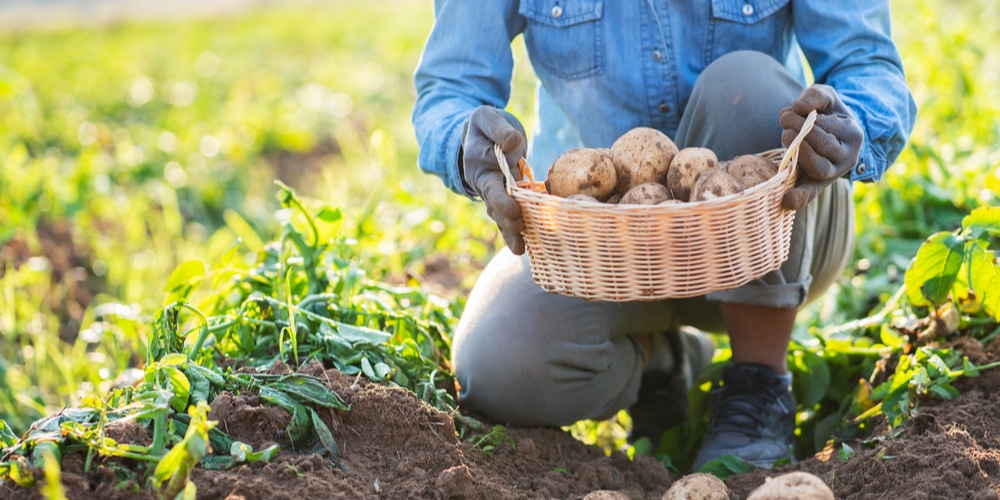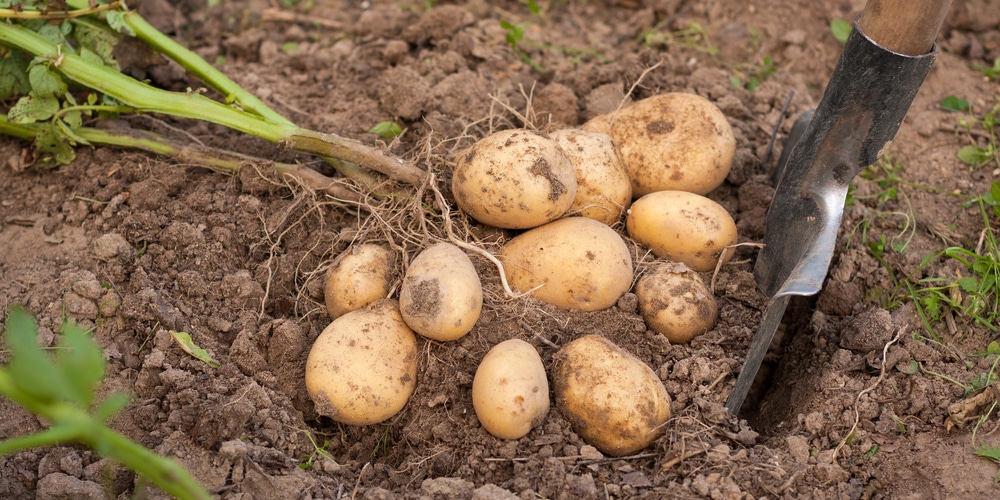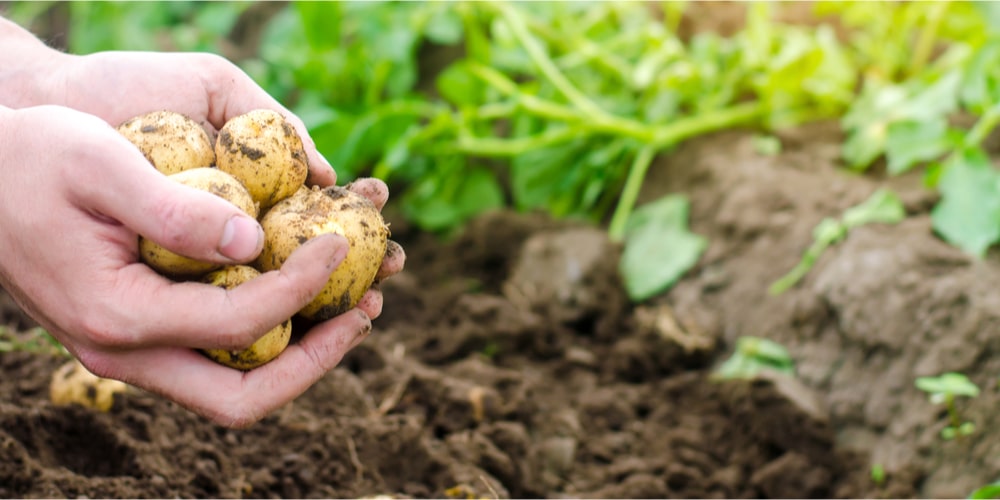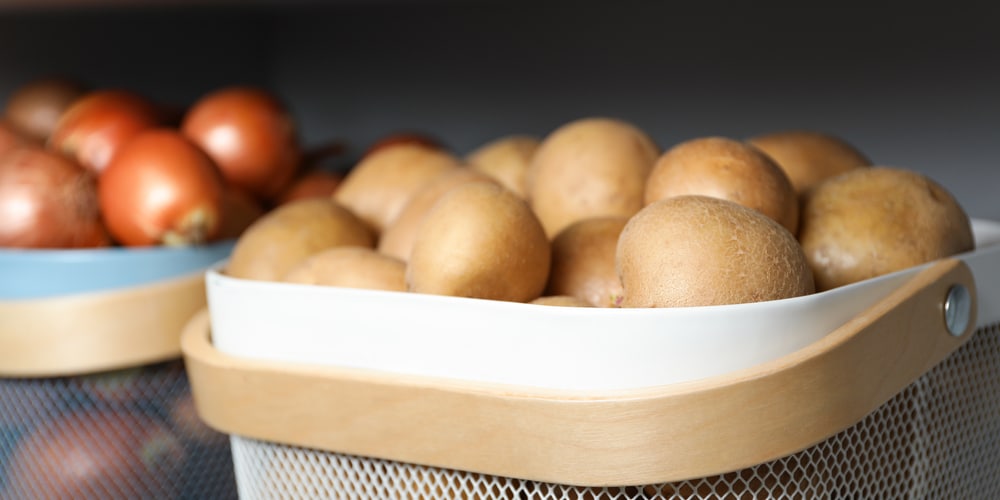A Complete Guide to Growing and Harvesting Potatoes
Potatoes are the most popular vegetable in America and much of the world. They are easy to grow and can be cooked in various different ways. If you’ve planted potatoes this year, you may be wondering when to harvest your potatoes and how to tell whether they are ready to be harvested.
If you’re growing potatoes in a temperate climate, you can plant your seed potatoes in spring and harvest the crop in the mid-summer through to the early fall. Let’s look at when to harvest potatoes, how to tell if your crop is ready to be harvested and how to successfully store potatoes so that they’ll last all winter.
When to Harvest Potatoes
Potatoes can be grown in various locations and climates; they do well in sunny conditions but can also thrive in colder weather. These diverse vegetables are successfully grown in over one hundred countries globally.
Potato plant’s growth will vary slightly depending on the variety you plant and the climate you live in. For example, if you live in horticultural zone 6a, your potato plants will take approximately 135 days to grow to maturity and be ready to harvest.
Early potato varieties take two or three months to reach maturity. They can be planted in the early spring when the days are cooler and are an excellent choice if you live in southern regions where the weather is hot.
Midseason potatoes can be grown across America and take slightly longer to mature. These varieties generally take between three and four months to reach harvest.
Late-season potatoes are best grown in northern America and take four or five months to mature and be ready for harvest.
How Does Climate Affect Potato Harvest?
Potatoes can be planted in the early spring if you live in a temperate zone or late Fall or even winter in warmer regions. If you live in a tropical climate, it’s probably best to grow potatoes in the winter as potatoes can wilt and die when the temperatures soar.
In ideal conditions, when the temperature is between 60° to 70°F, potatoes will be ready to harvest in 90 days. If you live in a cooler area such as North America, northern Europe, or Canada, the same variety of potatoes will take approximately 150 days to mature.
How to Tell When to Harvest Potatoes?
New potatoes can be harvested about six or eight weeks after they start to grow. Wait until after the plant’s flowers have bloomed before digging your potatoes. New potatoes are small are often referred to as baby potatoes because they are between one and two inches in diameter, sometimes smaller. You may like to harvest some potatoes when they are small and leave the rest to get bigger. Dig around your potato plant lightly and gently remove a few tubers, then leave the rest to grow. It’s best to remove a few small potatoes from each of your plants.
A good tip is to put straw around your potatoes plants as this makes it easier to harvest some new potatoes without digging up the whole plant. It’s also best to eat your new potatoes as soon as possible after being harvested, as young potatoes have thin skins that cause moisture loss.
Main Crop Potato Harvest
It would be best if you harvested your main crop of potatoes in the late summer or fall when they are mature. Depending on the potato variety and climate, your potatoes will be ready after seventy to 120 days. You can wait until the potato plants’ steam and leaves have started to turn yellow or brown before harvesting.
Before harvesting your potatoes, you may like to water them slightly as this helps to loosen the soil and makes the crop easier to dig up. Your potatoes will also be less prone to bruising and less likely to become damaged during harvest.
To harvest your potatoes, use a garden lifting fork and carefully dig around your plants. Lift up the soil from underneath each potato plant and then remove all the potatoes by hand.
How to Store Potatoes
You can harvest your whole potato crop at once when the plant has started to die back. Potatoes can then be stored throughout the winter and will last several months, as long as they are in a cool, dry place.
You can store your potatoes in a paper bag or crate. Rub the excess soil off the potatoes before storing them, but don’t wash them as they keep better if they aren’t washed. Potatoes will stay fresh as long as the temperature doesn’t rise above 50°F. Don’t expose your store of potatoes to light, as this will cause them to turn green and go soft due to a pigment called chlorophyll.
It’s also a good idea to sort through your potatoes before storing them to remove any that are damaged. These potatoes can be eaten on the day of harvest. Don’t attempt to store your potatoes in the fridge as this is too cold an environment, and the potato starch will begin to change into sugar and turn the potatoes brown.
You should also avoid storing potatoes close to fruits such as apples and pears as these produce ethylene, which is a plant hormone that will cause potatoes to sprout.
Conclusion
There are many different varieties of potatoes which are enjoyed worldwide. These hardy vegetables can be grown in various climates and do well in cooler weather. Potatoes take between three and five months to reach maturity and be ready for harvest.
Potatoes are ready for harvest after their flowers have bloomed and the plants have begun to die back. You’ll notice that the plants have started turning yellow and then brown. This is an indication that you can dig your potatoes and then store them in a cool, dry place. Always cover your potatoes or keep them in a paper sack so that it’s dark. Potatoes that are exposed to the light will produce chlorophyll, which will turn the tubers green and encourage them to sprout.
If stored correctly, your potato harvest will last for weeks, if not months, and can be used to feed your family throughout the fall and winter. You can even eat some types of potato leaves!



